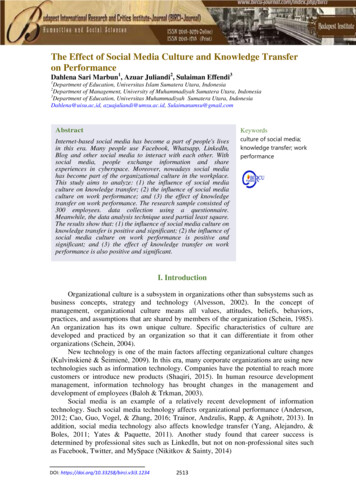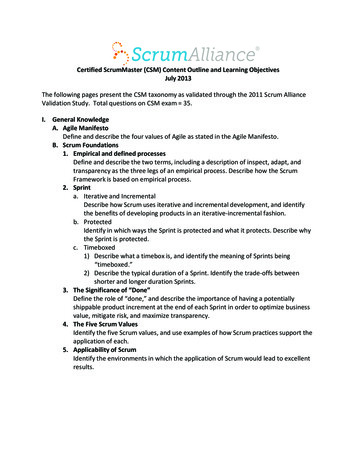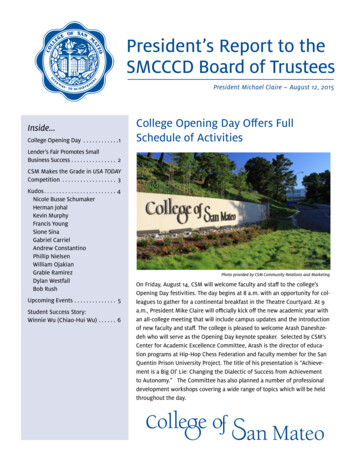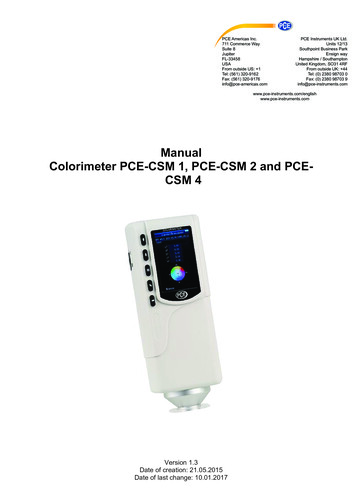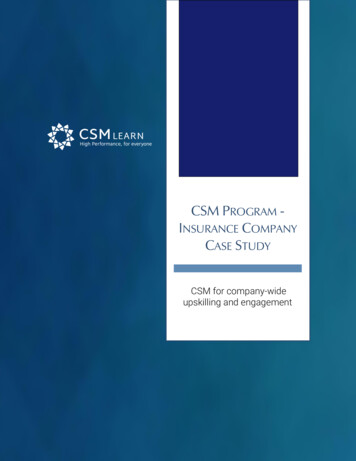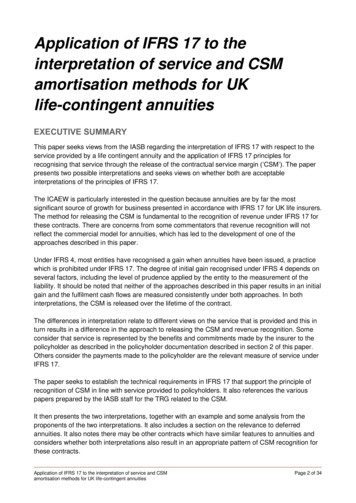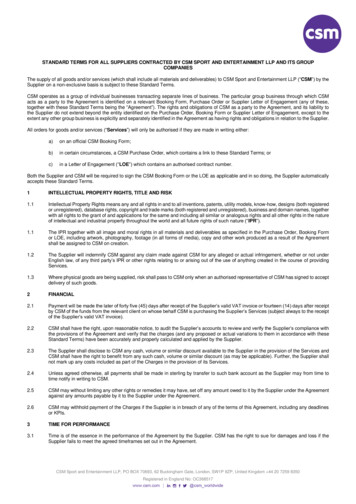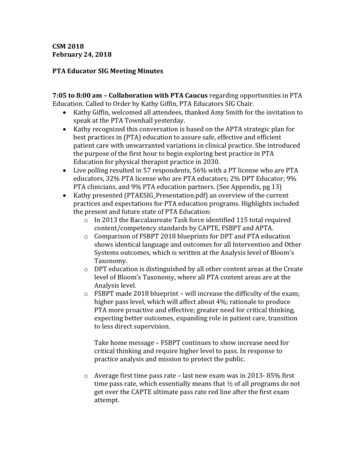
Transcription
CSM 2018February 24, 2018PTA Educator SIG Meeting Minutes7:05 to 8:00 am – Collaboration with PTA Caucus regarding opportunities in PTAEducation. Called to Order by Kathy Giffin, PTA Educators SIG Chair. Kathy Giffin, welcomed all attendees, thanked Amy Smith for the invitation tospeak at the PTA Townhall yesterday. Kathy recognized this conversation is based on the APTA strategic plan forbest practices in (PTA) education to assure safe, effective and efficientpatient care with unwarranted variations in clinical practice. She introducedthe purpose of the first hour to begin exploring best practice in PTAEducation for physical therapist practice in 2030. Live polling resulted in 57 respondents, 56% with a PT license who are PTAeducators, 32% PTA license who are PTA educators; 2% DPT Educator; 9%PTA clinicians, and 9% PTA education partners. (See Appendix, pg 13) Kathy presented (PTAESIG Presentation.pdf) an overview of the currentpractices and expectations for PTA education programs. Highlights includedthe present and future state of PTA Education:o In 2013 the Baccalaureate Task force identified 115 total requiredcontent/competency standards by CAPTE, FSBPT and APTA.o Comparison of FSBPT 2018 blueprints for DPT and PTA educationshows identical language and outcomes for all Intervention and OtherSystems outcomes, which is written at the Analysis level of Bloom’sTaxonomy.o DPT education is distinguished by all other content areas at the Createlevel of Bloom’s Taxonomy, where all PTA content areas are at theAnalysis level.o FSBPT made 2018 blueprint – will increase the difficulty of the exam;higher pass level, which will affect about 4%; rationale to producePTA more proactive and effective; greater need for critical thinking,expecting better outcomes, expanding role in patient care, transitionto less direct supervision.Take home message – FSBPT continues to show increase need forcritical thinking and require higher level to pass. In response topractice analysis and mission to protect the public.o Average first time pass rate – last new exam was in 2013- 85% firsttime pass rate, which essentially means that ½ of all programs do notget over the CAPTE ultimate pass rate red line after the first examattempt.
o Trends identified from CAPTE PTA Program Aggregate 2016-17 Data1. Average length of technical studies – decreased going down,now at 40 weeks; dropped from 48.2. Total length of program increased in last 10 years from 63.5 to77 weeks.3. Total credit hours on an increase – 78 total credit hours; somestates are limited to 65 credit hours.4. Pass rate has stayed about the same5. Class size has decreased to 24.36. Qualified applicants have decreased from 74 to 51.7. Previous degree has increased from 28% to 31.63%. Audience Comments: Although trend is increasing credit hours, somestates are setting a max. Live polling results: Ohio, 65 with possible moveto 60; Texas, 66; Wisconsin, 60; Tennessee, 70; Missouri, 72, WestVirginia, 60. More research on this is needed. (See Appendix, pg 13) B. McKnight raised the issue of students taking closed to 4 years to earnthe PTA degree and need for more data regarding actual program length,including prerequisite/application process.Kathy suggested it might be easier to gather data regarding earned credithours upon graduation.Live polling with 51 responses to the question “Is the current model ofPTA education sustainable?” Results: 20% Yes; 51% No, 29% Not Sure.(See Appendix, pg 13)Kathy acknowledge conversations during the past decade have revolvedaround a binary choice between the Associate or Bachelor’s degree.Recently the report from Best Practice in clinical education planted theseed of multiple entry points, which has also been a current topic withinthe occupational therapy community. She asked small groups to considerthe benefits, risks and recommendations regarding the three possiblepaths forward:o Continue Associate Degree onlyo Move to Bachelor’s degree entry-levelo Allow multiple degree options for entry-level Data was collected by recorders for each group. Results are included atthe end of this document.8:05 AMBusiness meeting – called to order by Kathy Giffin, PTA EducatorsSIG ChairOrganization representatives present:PTA Educator SIG Executive TeamKathy Giffin, Chair
Heather Wells, Nominating CommitteeJonna Schengel, SecretaryPTA CaucusLisa Stejskal, Liaison to PTAESIG & ELPAmy Smith, Chief DelegateELP PTA Education SubgroupRoger Herr, APTA BODKathy Giffin, PTAESIGLisa Stejskal, PTA CaucusLisa Finnegan, CAPTEAnn Reicherter, APTA StaffAPTA StaffAnn Reicherter, Director of Academic and Clinical AffairsGreg Awarski, Customer Solutions Manager, Liaison InternationalRyan Bannister, Director of Centralized Application Services and StudentRecruitmentCAPTELisa FinneganFSBPTNancy Kirsch, President, Board of DirectorsJeff Rosa, Managing DirectorEducation Partner Reports:Ann Reicherter, PT, DPT, Ph.D. – Director of Academic and Clinical Affairs fromAPTA ANNEREICHERTER@APTA.ORGA. Education Leadership Partnership2018 Update – Agreement in 2016 among ACAPT, APTA and EducationSection into one group called ELP, Education Leadership Partnership – idealoutcome is to reduce unwarranted variation in practice by focusing on bestpractices in education.Various workgroups:Excellence in Education Task Force from APTAClinical Education Task Force from APTAOther issues: PTA Issues and Student DebtNow working on a strategic plan to gather information from the two taskforcesGoal is to cover need in the clinical site placement.CPI learning courses PT/PTA revisionsConsolidating CPI/CSIF webpagesClinical Education Technology Work Group – better connect all resourcesB. Educational Leadership Institute (ELI) Fellowship ; 13 months fellowship –PTA PD are absolutely encouraged to apply. www.apta.org/ELI/Overview/
C. PTA CPI Training module – will be shortening and fixing the breaks inservice; will be done by summer.D. Web services – informational pages – one stop shopE. PTNOW – APTA Evidence based portal; must be used in PTA curriculum.Many resources there; must be a member to use it – but there are manyresources including free books. New Kisner/Colby textbook electronic copyis free; also a free medical dictionary. Helps value APTA membership.F. Questions: Task Forces were exclusively to DPT education, so what is the role inELP?Integrated model – doesn’t convey PTA issue – work on model; visually doesnot represent PTA education, it lists it as a “problem” PTA issues is in yellowas is Student DebtAPTA and Education sections have been pushing for PTA Educationinclusion – now at beginning at PTA education are represented in those ELPsubgroups.Question about wording of “unwarranted” – getting rid of variation of theproduct/outcome you produce- therefore same level of skills. Not astandardized curriculum.Question about ACAPT? How was it created? Institutions of DPTprograms, American Council Academic Physical Therapy/ACAPT, created it.Greg Awarski, for CPI & CSIF Web Apologized about delays regarding customer support workflow. CPI webbalance between “teach” vs. work with the product and then askquestions. Changed procedure in workflow – different email addressesfor various pport@liaisonedu.comcsifwebsupport@liaisonedu.com Also developed new training materials Provided card with phone numbers and encouraged to call Developed updated HELP Center; webinars are no longer live butrecorded – available ON DEMAND. Ready online soon. Updates – customer 257 PTA schools that use CPI; CSIF – 43,000 sitesnation wide; 33,000 not started. Value input from PTA SIG Discussed the benefit of increasing cost in order to provide betterservice? Budgetary concerns and requests can be made to LIASON.
Question – how many of CSIF are being completed by students?Not able to tell at this time; do get questions from students, so they knowstudents are filling them out.Question – possible to upload clinical ed manuals to the CPI website?Often ask if things from APTA and programs could be posted to the CPI website.Question – CI often would check box but did not have all the boxes done ormake final sign off box bigger?No longer have a SAVE feature, therefore auto save, it will be saved; will see agreen check. Training tools for CI, which is important.Question – when will be smart compatible?One of the only feature – big feature that cannot be done; enhancement requestthat will be recorded.Kathy Giffin thanked all who have participated in surveys promoted through thePTA SIG list serve: Student Debt data is not yet available, there was a strongresponse to Best Practice in Clinical education surveys, and she introduced Ryan toprovide update regarding PTA CAS survey.Ryan Bannister, PTA CAS Survey Has a desire to PTA CAS survey – conducted in fall; great response of 50%.Inconclusive news is that about 39% yes, please tell us more; about 31%might join; But not an overwhelming response Want to establish a work group about CAS for PTA programs. He left his card if you are interested. Student recruitment – interested in expanding pipeline USA Science and Engineering Festival – every 2 years in Washington, DC;400,000 K-12 students. HOSAA- Future Health Occupation Students – grades 7-12; college in anothercompetition; APTA is sponsoring and judging PT type activities. Please share any ideas for student recruitment.Question – can you reproduce presentations/handouts for recruitment in localareas?Yes, there will be resources for state chapters and at the program levels. Serve asmentors.Amy Smith, PTA Caucus Chief DelegateLisa Stejskal, PTA Caucus Rep, ELP PTA Rep Working on making PTA more visible about what PTA are doing today.;showed video
2019 is the 50th Anniversary of the PTA and will be working on#BETTERTOGETHERPlease use for students to be members.Increase in PT membership – working toward 100,000. Continue to growPTA membership to #PTA10K; goal is to get 10,000 PTA members.Encourage using social media to improve awareness and promotemembership.When you like, share, post and tagging people – it helps spreadPTA Town Hall Meeting – Sharon Dunn, APTA President, Justin Moore, BOD,Justin Elliot, APTA – good cooperation and interaction in the past few years.Told the story of the repeal of the CAP, which the APTA has been fighting for20 years, but also put a rate reduction of 85% for PTA services/PTAdifferential. Sharon Dunn and Justin Moore, contacted Amy immediately.Historically fast bill through both house and senate; one week from Monday,There will be differentialJan 2020 when furnished in full or part, must be coded.Jan 2022 when furnished in full or part, will be paid at 85% PFS.APTA and OATA are strategizing together on how to approach.There will be a fight to get this reversed.30% of PT and 10% of PTA are now members. Value of APTA membership isimproving.37 states, 9 chapters allowing PTA to have full vote; one year ago. Encouragevalue of a full vote to increase involvement.Next year is 50th anniversary of the PTA and there will be a “party”.Celebration will be in June 2019 in Chicago at Annual meeting.Encourage educators to do local events – all PTA students and programs arecelebrating the 50th Anniversary.Win of TRI Care to pay equally forGood comments on PTA Caucus work by Amy; but more respect from theAPTA leadership.Nancy Kirsch, & Jeff Rosa - FSBPT Update FSBPT publishes a quarterly newsletter for educators; able to defer examincrease; will stay at 400 until Jan 2019. Exam updates are on FSBPT website; update on PEAT. Help students prepare with materials to prepare for the test. Health Care regulator research institute – this might access for research. Improved communication with APTA and FSBPT – same page and goodworking relationship – common purpose such a minimum data set; to get abetter idea of how many PT and PTA are actually practicing. Jeff Rosa, FSPBT Manager PT Licensure Compact – close to first privilege ready with 15 states inCompact. Goal is 20-28 states by end of 2018. Transfer from home state toother states in the compact.
FSBPT/APTA – use of Aptitudes – upload all – free continuing licensing andrecord all their activities; all APTA activitiesAptitude Account – available for students –Exam Registration system – has been going for a year; enter all your studentsby end of the first year. Benefit of adding earlier – it allows FSPBT so theycan plan with Prometric when needed for each exam at each test center.Helps manage testing sites.Email reminders are great.Posted on the Educator Log in page, copies of all emails students will receive.Will try to come up with other screen shots, so you can see what the studentscan see. All licensing will see the same dashboard as students.Essential Tasks vs. NonEssentail Task by FSBPT.Lisa Finnegan, PTA - CAPTEQuestions – What steps to would CAPTE make to accredit multiple levels?Commission looked at this a few years ago and decided not to make anychanges. In the future, it could be looked at again.Questions – What are the steps CAPTE would have to make to accredit both?Would the steps be similar to PT, to MPT, DPT?CAPTE would identify the standards, and either degree for a period of time.Based on standards. But CAPTE is not accrediting Bachelor’s degree so thesteps are still not clear.Processes are possible, but the details are not available yet. Lisa will explore ifa paper can beQuestions – CAPTE published the aggregate data on citation per criteria? Inthe past, programs had citations on various criteria.o Information is made available at Self Study workshops; Announced thatCAPTE will come to you for private self-study workshops – two full dayswith Lisa Fennigan/CAPTE. CAPTE wants to be partner, not a policestate.o Assessment of Curriculum and Program – since it was so common, thereis a Assessment Module in APTA Learning Center.o Monitors PTA Educator Facebook page to be aware of commonproblem/concerns.o PTA voice at CAPTE/APTA – Lisa and Michael are both PTAs and thevoice at APTA.Questions – With possible market downturns with USDE, will it alter our90% employment requirement?o 97% of programs at least meet the minimum of 90%.
o CAPTE feels like it has a hard time to make it lower, but if there it islower, adjustments can be made. USDE complimented CAPTE becausethey had set specific benchmarks.o Might be required to use an outside company to track employment.CAPTE did pilot it with one program. Third party – give them yournumbers; give two recent graduates. Students need to let programknow where they are employed. Cost is 25 per student o Does not look like it coming any time soon.Questions – Clinical sites with letter of support – is there any way to tell ifother programs commitments will be decreased.o Not at this point, it is up to the programs/clinics to work together forplacement.o Post meeting follow up provided clarification that this information isincluded in the Letter of Intent required for Candidacy.9:45 amKathy Giffin, SIG Business Announced that anyone who did not receive an email from PTAESIG-listservein the past 24 hours should check their spam and/or check to make sure theyare registered for the listserv. Reminded all that joining the PTA EducatorsSIG list serve is a separate process from Joining the SIG. On the APTAEducation website; Members tab Select Join our Listserv. Announced that education Section has RFP to update the website. Goal is toprovide more functionality and make it mobile friendly. Kathy noted that all requests for PTA educator volunteers are announced onthe listserv. Announced current need for doctoral trained PTA Educators who would liketo serve on the JOPTE editorial board. Must have at least 1 peer reviewedpublication. Kathy noted the importance of the new partnership with ELP through thePTA Education subgroup. Regular meeting provide an opportunity tobrainstorm about PTA education issues and solutions. Actively working tohave PTA educators represented on other subgroups, especially in facultydevelopment and research. Recent activities of the PTAESIG leadership include:o Participation in the PTA CAS & Student Debt Surveyso Collaboration with the PTA Caucus to raise awareness of education issueso PTA Caucus Collaboration Education Section Newso Approved name change to the Academy of Physical Therapy Educationo Now have 6 SIGS, newest is Anatomy, members can join as many as theywant.o Website updates are in process
o Appointed new Task Force to explore committing up to 1,000,000 forEducation Research. Kathy noted PTA SIG needs to be active and vocal tomake sure PTA education is included.o Recommend those interested in PTA Education research join theScholarship SIG who can help identify a mentor.Nominations for Vice Chair, Secretary and Nom Committee were presented.Unfortunately time constraints do not allow review of small group activities.There was a hope to review the various models – gathered data will beprovided on the SIG webpage when minutes are posted. (See Appendix, pg10)Live polling question with 31 responses to questions “Which PTA entry-levelmodel is most likely to best serve our patients and the profession in 2030?(See Appendix, pgo Associate 6%o Bachelor’s 32%o Multiple Entry points 61%Kathy sought input regarding the PTAESIG Priorities for the coming year.Live polling was unsuccessful with only 5 responses secondary to runningout of time. (See Appendix)o Associate Degree min instead of maxo BA level – RC20-12o Eliminate practice variationso HOD RC for Excellence in PTA educationo National PTA Education Consortiumo PTA Education Summit with APTA, CAPTE, FSBPT,Sections,Caucus, etcAnnounced ELC in Jacksonville, Florida, October 12-14; acknowledgedcomments/concerns regarding programming for PTA Educators, noting thatthis is due to a lack of proposals. She reminded all that ELC 2018 and CSM2019 proposals are due the end of March.Future conferences include CSM 2019 in Washington DC & ELC 2019 inWashington State.Respectfully submitted,Jonna Schengel, PT, MA, Ed.D.PTA SIG Secretary
PTA Educators Small Group Brainstorming Activity at CSM, 2018Multiple Entry PointsBenefits:With consideration of all parties of interest (patients, practitioners, students,institution), list any identified BENEFITS of a physical therapy education model withmultiple entry points. [Majo.More time for technical skillsDon’t lose students who can’t afford it initiallyCan build upon the associates degreeBetter bridgeBS PTA should have more in their scope/abilitiesAllow diversity in student population - won't hurt those who attend communitycollegesDoes not knock out anyoneKeeps cost downAllows Community Colleges to keep teaching PTA programsAllows Community College faculty to keep teachingAllows us to spread things outFoster optional job entryLike the idea of 3 year BSNGood model in ADN/RN to BSNSo many already have degrees so they need the option of just getting an AS degreeIt would allow us to develop bridge for PTA to DPT programsFollow or COTA/OTA programsThis option puts the power in the student choice; does not help or hurt anyoneDoesn’t “lock” others out due to cost or other reasonsCost savings for students, 1st time students, families,Community colleges can continue to support student’s needs and finding qualifiedfacultyRelive stress on staff, spreads out content over faculty if able to offer multiple levelsAllows students the ability choose the level they wantAllows the student who already has a BA/BS to choose the AASAllows more “bridge” type programs, also allows students to“Fills” a need for aging populationCan improve the satisfaction of the student- natural groundCould give a time frame (start with AS- within 5 years get the BS, start a transition)Patients Improved credibilityGood options for those w/out a BS
RISKSWith consideration of all parties of interest (patients, practitioners, students,institution), list any identified RISKS of a physical therapy education model with multipleentry points. [Major .Need to have a benefit for the BS- how do you differentiate?DisenfranchisementHiring discriminationCostBoard exam?What happens to community colleges?Might hurt AS degree studentWill it negatively affect pay for the PTACould we maybe give them 5 years to get a BS.Could affect payCould affect jobs, decrease the employability of the ASHurt the “pure” ASDoesn’t change the “bottom line” of what is expected from CAPTE from the AS degree student debt & return on investmentconfusion to consumerRecommendations:Are there specific recommendations to assures graduates are prepared to provide safeand effective patient care for efficient physical therapist practice?We do it now!We did not get to this question.Debate on if DPT "elevated" our professionCould it "flow" to BS by starting with multiple? about Gen Ed being most
PTA Educators Small Group Brainstorming Activity at CSM, 2018Associate DegreeBenefitsWith consideration of all parties of interest (patients, practitioners, students,institution), list any identified BENEFITS of continuing the entry-level Associate degreemodel. [Major points are.Increases Patient access, reasonable cost of education, more accessible to students,diversity of PTAs, More flexible model within HealthcareRisksWith consideration of all parties of interest (patients, practitioners, students,institution), list any identified RISKS of continuing the entry-level Associate degreemodel. [Major points are i.Payment- argument more difficult; data- consistent pass rates; time- taking more than 2yearsRecommendationsAre there specific recommendations to assures graduates are prepared to provide safeand effective patient care for efficient physical therapist practice?Opportunity- what do we want?Question 7- Felt it was the incorrect question- only if everything froze as is
PTA Educators Small Group Brainstorming Activity at CSM, 2018Bachelor’s Degree OnlyBenefitsWith consideration of all parties of interest (patients, practitioners, students, institution),list any identified BENEFITS of changing to a PTA entry-level Bachelor degree model. [Majorpoints a.Adding more technical component, will increase better base knowledge before teachingtechnical component, will cost the 35 gaps of needed education for effective clinical practicebased on university of Utah ( ), may help with reimbursement, stay inline with otherprofessions, ability to have skills for increasingly complex patients, healthcare changes,damaging our students by cognitive loadRisksWith consideration of all parties of interest (patients, practitioners, students, institution),list any identified RISKS of changing to a PTA entry-level Bachelor degree model. [Majorpoints are.Lose students who are 2nd career, student cost, cost of education, institutions not beingable to matriculate bachelors degrees, finding qualified faculty, if increasing clinical timefinding clinical placements, faculty preparationRecommendationsAre there specific recommendations to assures graduates are prepared to provide safe andeffective patient care for efficient physical therapist practice?Increase of depth of content, more clinical education, standands (red flags) need to beexpanded
Live Polling resultsPTA Educators SIG MeetingFebruary 24, 2018
Education for physical therapist practice in 2030. Live polling resulted in 57 respondents, 56% with a PT license who are PTA educators, 32% PTA license who are PTA educators; 2% DPT Educator; 9% PTA clinicians, and 9% PTA education partners. (See Appendix, pg 13) Kathy presented (PTAESIG_Presentation.pdf) an overview of the current

